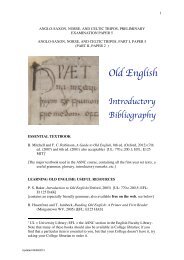Scandinavian history in the Viking age - Department of Anglo-Saxon ...
Scandinavian history in the Viking age - Department of Anglo-Saxon ...
Scandinavian history in the Viking age - Department of Anglo-Saxon ...
You also want an ePaper? Increase the reach of your titles
YUMPU automatically turns print PDFs into web optimized ePapers that Google loves.
<strong>Scand<strong>in</strong>avian</strong> History <strong>in</strong> <strong>the</strong> Vik<strong>in</strong>g Age<br />
Royal biographies<br />
Of <strong>the</strong> biographies produced <strong>of</strong> <strong>the</strong> Frankish emperors, only those <strong>of</strong> <strong>the</strong> Carol<strong>in</strong>gians <strong>of</strong> <strong>the</strong> n<strong>in</strong>th<br />
century have much direct <strong>in</strong>formation on Scand<strong>in</strong>avia; for Rimbert’s life <strong>of</strong> Anskar, see (B72).<br />
[B40] For an anthology with text and German transl.: R. Rau et al., Quellen zur karol<strong>in</strong>gischen<br />
Reichsgeschichte. I: Die Reichsannalen; E<strong>in</strong>hard, Leben Karls des Grossen; zwei ‘Leben’ Ludwigs;<br />
Nithard, Geschichten, AQDGM 5 (1956) [UL 570:01.c.57.5]<br />
[B41] Various accounts were composed on <strong>the</strong> life and deeds <strong>of</strong> Charlemagne. The standard is that <strong>of</strong> [a]<br />
E<strong>in</strong>hard (died 840), a court <strong>of</strong>ficial who composed his Vita Karoli around <strong>the</strong> 820s. Text: O. Holder-<br />
Egger, E<strong>in</strong>hardi Vita Karoli magni, 6th edn, MGH SRG (1922) [UL 570:01.c.8.26]. Text and transl.: E.S.<br />
Firchow and E.H. Zeydel, E<strong>in</strong>hard: <strong>the</strong> life <strong>of</strong> Charlemagne (1972) [UL 560:46.d.95.6]. Text and<br />
German transl. <strong>in</strong> (B40):157-211. Transl.: (B36):24-43 or P.E. Dutton, Charlemagne’s courtier: <strong>the</strong><br />
complete E<strong>in</strong>hard (1998). A slightly later life, but conta<strong>in</strong><strong>in</strong>g some <strong>in</strong>terest<strong>in</strong>g observations, is that <strong>of</strong> [b]<br />
Notker balbulus ‘<strong>the</strong> stammerer’ (died 912), who composed his Gesta Karoli around 887. Text: H.F.<br />
Haeffete, Notker der Stammler, Taten Kaiser Karls des Grossen, MGH SRG n.s. 12 (1962) [UL<br />
570:01.c.10.11]. Text and German transl.: (B60a):321-427. Both lives are translated <strong>in</strong> L. Thorpe,<br />
E<strong>in</strong>hard and Notker <strong>the</strong> stammerer: two lives <strong>of</strong> Charlemagne (1969) [UL 9560.d.134]<br />
[B42] For Louis <strong>the</strong> Pious two fur<strong>the</strong>r biographies are also relevant, as well as <strong>the</strong> poetic account by<br />
Ermold (B47). [a] Thegan(us) or Theganbert composed his Vita Hludowici imperatoris ‘life <strong>of</strong> emperor<br />
Louis’ <strong>in</strong> <strong>the</strong> late 830s. Text: E. Tremp, Theganus: Gesta Hludowici imperatoris, Astronomus: Vita<br />
Hludowici imperatoris, MGH SRG 64 (1995) [UL 570:01.c.8.38]. Transl.: (B36):141-55. Text and<br />
German transl. <strong>in</strong> (B40):213-53. [b] There is also a fur<strong>the</strong>r anonymous life by <strong>the</strong> ‘Astronomer’, which<br />
can be found <strong>in</strong> Tremp’s edition and (B40):257-381. Transl.: A. Cabaniss, Son <strong>of</strong> Charlemagne: a<br />
contemporary life <strong>of</strong> Louis <strong>the</strong> Pious (1961) [UL 560:46.d.95.2]. For commentary, see: E. Tremp, Studien<br />
zu den Gesta Hludowici imperatoris des Trierer Chorbisch<strong>of</strong>s Thegan, MGH Schriften 32 (1988) [UL<br />
570:01.c.3.40]<br />
Verse<br />
Only a small portion <strong>of</strong> <strong>the</strong> large amounts <strong>of</strong> Carol<strong>in</strong>gian verse is cited here; for a general overview with<br />
reference to <strong>the</strong> Norse, see:<br />
[B45] T.M. Andersson, ‘The Vik<strong>in</strong>g im<strong>age</strong> <strong>in</strong> Carol<strong>in</strong>gian poetry’, (O22):217-46<br />
[B46] Paul <strong>the</strong> Deacon (died c. 799) is best known for his <strong>history</strong> <strong>of</strong> <strong>the</strong> Lombards, but he was also <strong>the</strong><br />
author <strong>of</strong> some poetry <strong>in</strong> <strong>the</strong> late eighth century, most relevant for his comments on <strong>the</strong> Danish k<strong>in</strong>g<br />
Sigifrid he was asked to visit on a missionary basis. Text: E. Dümmler, Poetae lat<strong>in</strong>i aevi Carol<strong>in</strong>i I,<br />
MGH (1881), 51-52 [UL R560.G116]; K. Neff, Die Gedichte des Paulus Diaconus, Quellen und<br />
Untersuchungen zur late<strong>in</strong>ischen Philologie des Mittelalters 3,4 (1908) [UL 716:01.c.17.3], 101-05; see<br />
also (B45):218-19<br />
[B47] Ermold nigellus or ‘<strong>the</strong> black’ composed his praise poem <strong>in</strong> honour <strong>of</strong> emperor Louis <strong>the</strong> Pious<br />
(<strong>the</strong> Carmen <strong>in</strong> honorem Hludowici) <strong>in</strong> 826; it is <strong>of</strong> particular <strong>in</strong>terest for <strong>Scand<strong>in</strong>avian</strong> <strong>history</strong> <strong>in</strong> Book<br />
IV, which tells <strong>of</strong> Louis <strong>the</strong> Pious sett<strong>in</strong>g up <strong>the</strong> early missions under Ebo, provides some observations<br />
on <strong>the</strong> pagan customs <strong>of</strong> <strong>the</strong> Danes, and gives an <strong>in</strong>terest<strong>in</strong>g account <strong>of</strong> Harald klak’s baptism at<br />
Ingelheim. Text: E. Dümmler, Poetae lat<strong>in</strong>i aevi Carol<strong>in</strong>i II, MGH (1884), 5-79 [UL R560.G116]. Text<br />
and French transl.: E. Faral, Ermold le noir: poème sur Louis le pieux et épitres au roi Pép<strong>in</strong>, Les<br />
classiques de l’histoire de France au moyen <strong>age</strong> 14 (1932) [UL 560:01.d.1.13]; cf. (B45) for background<br />
[B48] Abbo <strong>of</strong> sa<strong>in</strong>t-Germa<strong>in</strong> was an eyewitness to <strong>the</strong> Vik<strong>in</strong>g siege on Paris <strong>in</strong> 885 and composed a<br />
long poem on it soon after. Text: G.H. Pertz, Abbonis De bello Parisiaco libri III, MGH SRG (1871) [UL<br />
570:01.c.8.9]; P. de W<strong>in</strong>terfeld, Poetae lat<strong>in</strong>i aevi Carol<strong>in</strong>i IV:1, MGH (1899), 72-121 [UL R560.G116].<br />
Text and French transl.: H. Waquet, Abbon, Le siège de Paris par les Normands: poème du IXe siècle,<br />
Les classiques de l’histoire de France au moyen <strong>age</strong> 20 (1942) [UL 560:01.d.1.19]. Excerpts transl. <strong>in</strong><br />
(B36):483-85<br />
9






